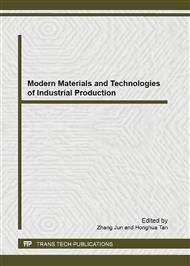[1]
Ji Sheng Lai, Fang Zheng Peng. Multilevel conveners-a new breed of power converters [J]. IEEE transactions on Industry Applications, 1996, 32(3): 509—517.
DOI: 10.1109/28.502161
Google Scholar
[2]
Pradeep M, B,V.R. Sfefanovjc. Generalized Structures of a Multilevel PWM Inverter[J]. IEEE Transactions on Industry Applications, 1983, 19(6): 1057—1069.
Google Scholar
[3]
Bhim Singh S.S. Murthy, Sushma Gupta. STATCOM-Based Voltage Regulator for Self-Excited Induction Generator Feeding Nonlinear Loads[J]. IEEE Transactions on Power Electronics. 2006, 53(5): 1437—1452.
DOI: 10.1109/tie.2006.882008
Google Scholar
[4]
CSchauder,H. Mehta, Vector Analysis and control of Advanced and Control of Advanced SVC[A]. Fifth International Conference on AC and DC Power Transmission[C]. London: 1991. 266~272.
Google Scholar
[5]
Walmir Freitas, Andre Morelato, Impacts of AC Generators and STATCOM Devices on the Dynamic Performance of Distribution Systems [J]. IEEE Transactions on Power Electmnics. 2005, 20(4): 1493—1501.
DOI: 10.1109/tpwrd.2004.839181
Google Scholar
[6]
Clark Hochgra, Robert H. Lasseter. Statcom Controls for 0peIation with Unbalanced Vo1tages[J]. IEEE Transactions on Power Electmnics, 2003, 19(4): 1242—1247.
Google Scholar
[7]
Y. Jiang-Hafher, Nl. Hyttinen, et al. On the Short Circuit Current Contribution of HVDC Light[J]. IEEE Transactions on Power Electronics, 2002, 2(4): 1 926—1 932.
Google Scholar
[8]
Qingmin Li, W. H. Siew, Member, IEEE, Martin G. Stewart, et al. Radiated Emissions From FACTS Equipment Operational Within Substations-Part III [J]. IEEE Trans. Power Delivery, 2005, 20(2): 1788—1796.
DOI: 10.1109/tpwrd.2004.834865
Google Scholar
[9]
Tarlochan singh sidgh, Rajiv KVarma, et al. Performance of Distance Relays on Shunt-FACTS Compensated Transmission Lines[J]. IEEE Trans. Power Delivery, 2005, 20(3): 1 837-1845.
DOI: 10.1109/tpwrd.2005.848641
Google Scholar
[10]
Y. Q. Xia, K. K. Li, A. K. David. 0peration of impedance protection relays with the STATCOM[J]. IEEE Trans. Power Delivery, 2002, 17(2): 381—387.
DOI: 10.1109/61.997904
Google Scholar
[11]
A. Kazemi, S. Jamali, H. Shateri, Effects of STATCOM on Distance Relay Tripping Characteristic[A]. 2005 IEEE/PES Transmission and Distribution Conference & Exhibition: Asia and Pacific[C], Dalian China.
DOI: 10.1109/tdc.2005.1547111
Google Scholar
[12]
Albasri F A; Sidhu T S; Varma R K Performance comparison of distance protection schemes for shunt-FACTS compensated transmission lines, 2007(04).
DOI: 10.1109/tpwrd.2007.900283
Google Scholar
[13]
Sidhu T S; Varma R K; Gangadharan P K Performance of distance relays on shunt-FACTS compensatedtransmission lines. 2005(03).
Google Scholar
[14]
Ren Minwei, Sun Yukun, Rao Xiang, et al. TheVoltage ControlMethod of DC Capacitors in Caseade STATCOM[A]. 29thChinese Control Conference[C]8. 2010: 4986—4991.
Google Scholar


